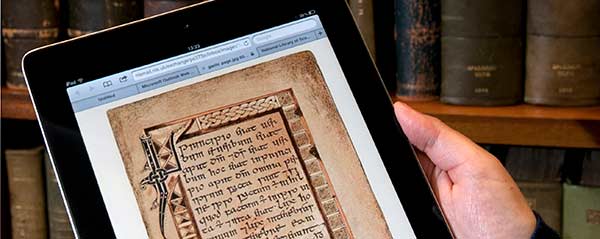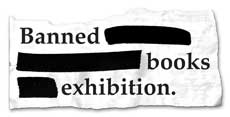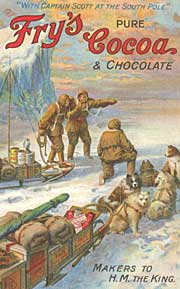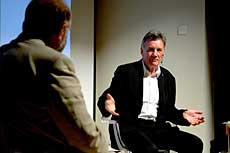
Introduction by the National Librarian and Chairman
We have been very pleased to see new evidence of our continuing success at widening access to the rich treasure house of material we hold on behalf of the people of Scotland.
This comes through in two key statistics from 2011-12. The number of visitors to our website exceeded 1.85 million, while those visiting our main building in Edinburgh to use our reading rooms or take in an exhibition or an event stood at almost 275,000. These are both record figures and clearly show that more and more people are interested in what they find at the National Library of Scotland (NLS).

Our main summer exhibition on 'Banned books', which explored the issue of censorship, was one of the most popular we have ever held. Targets were also exceeded for our winter exhibition 'Beyond Macbeth', on how Shakespeare has been seen from Scotland down the centuries. Meanwhile, our annual programme of events continued to be extremely popular.
While we continue to work on providing a high level of service to visitors to the Library in Edinburgh, we are now rapidly expanding the amount of information that can be accessed online, to allow people to benefit from our collections wherever they are based. More than 500,000 new digital objects were created from material in our collections throughout the year.
We are encouraged by the positive response to the information being made available online. Our online collection of Gaelic literature, to give just one example, has also proved very popular, clocking up hundreds of thousands of downloads in the first few months after its launch.
Online access is also provided to content that we licence from others and do not own ourselves. One example of this is free business information, available through our SCOTBIS service. This gives Scottish companies access to information about customers, suppliers, business partners and competitors to help them grow and prosper.
Schools and adult learners are benefiting as well from the Library's huge bank of knowledge through accessing our Learning Zone. This is a section of the NLS website that has been specially developed to support school students and adult learners in their studies. Our learning team also worked with schools in Moray throughout the year on an educational project to develop a unique travel guide that has been made available as a mobile app. This is a good example of how our archive material can be used in new ways to inspire local people to tell the story of their own area.
One of most important developments in 2011-12 was the publication of the National Library of Scotland Bill and its consideration by the Scottish Parliament. This legislation modernises the structure of the Board and the powers and functions of NLS and will strengthen our role in safeguarding and sharing our collections for future generations. The Library has changed immeasurably since the previous legislation was passed in 1925 and the new Bill is very welcome as it recognises and reflects our role in the 21st century. We have been appreciative of the many positive comments made about the Library’s work and for the careful scrutiny paid by legislators to the detail of the Bill. The early stages of the legislation were completed throughout the year and the Bill was approved in May.
While the digital information revolution presents us with new opportunities to make our collections more widely available, it also presents challenges. In particular, more and more information is being produced only in an electronic format and there is a great risk that much of it could be lost forever. We are pleased that the UK Government has launched a public consultation on draft regulations that will allow legal deposit libraries like NLS to collect a copy of everything published electronically, just as we can do for printed material. This will help us preserve this material for future generations.
We continue to add more than 5,000 printed items a week to our collections mainly through legal deposit and, during the year, the number of printed items we hold passed the 15 million mark. Through these collections, we chart the global and historical influence of Scots at home and abroad, while also recording and reflecting the ideas and cultures of the world.
The great philanthropist Andrew Carnegie, who established public libraries around the world, described a library as 'a never failing spring in the desert'. Some people question their future in the digital age. Our increasing visitor figures show that not only are libraries as relevant as ever but there is an increasingly important place for them in the 21st century.
Professor Michael Anderson
Chairman of the Board of Trustees (until October 2012)
Martyn Wade
National Librarian and Chief Executive
Objectives and achievements
During 2011-12, the National Library of Scotland was guided by the strategic goals outlined in its new corporate strategy 'Connecting knowledge'. These goals fall into broad themes: Content, Connectivity, Collaboration and Organisational Development.
Collecting

Collecting, preserving and sharing knowledge is our key function. The range of our collections is vast from medieval manuscripts, historic maps and photographs, to the order for the massacre of Glencoe, the last letter of Mary Queen of Scots, film posters, football programmes and Harry Potter. We also collect significant digital material and film, through our Scottish Screen Archive.
We aim to collect Scottish material as comprehensively as possible, working closely with the Agency for Legal Deposit Libraries which is located in our Causewayside building. We also aim to meet the needs of our readers for non-Scottish content. In 2011-12, we acquired more than 265,000 new printed items through legal deposit and by traditional routes including purchase and donations.
One remarkable item we acquired was a memorial book which records the tributes paid by visitors to the grave of Lord Byron between the years 1825-34. It was donated by Mrs Marilyn Solana from Savannah in the United States who bought the book for a few dollars at a local church bazaar. She decided to donate the book to NLS which holds the most important collection of Byron's work in the world through the John Murray Archive. The new find will further enhance this collection.
Other important acquisitions included
- An extensive addition of papers to the John Murray Archive donated by the Murray family. They include material related to individual authors, including the original manuscript of Samuel Smiles' 'A publisher and his friends', papers relating to the 'Quarterly review', business papers and ledgers, and personal and family letters, diaries and notebooks of John Murray III, IV and V which provide an unparalleled insight into their private and business lives. Original drawings by Osbert Lancaster, one of Britain's leading cartoonists whose work appeared in the 'Daily Express' from 1939 to 1981, are also included
- A collection of six Scottish single-sheet items printed before 1700 that were acquired at auction. They were formerly part of a bound volume of mainly 17th-century broadsides and pamphlets. They include proclamations, an act and ratification, and a printed document concerning Acts of the Scottish Parliament
- A rare Hungarian translation of Adam Smith's seminal work 'Inquiry into the nature and causes of the wealth of nations' which is an important addition to the Library's extensive collections of material relating to the Scottish economist. It has a lengthy introduction by the noted economist, politician and banker Gyula Kautz (1829-1909), who was Governor-General of the Central Bank of Hungary from 1893 to 1900. The only other known copy of this translation is located in the Hungarian National Library
- The 'Official Celtic Opus European Champions edition' celebrates the first British team to win the football European Cup. This large-scale volume is one of only 500 published and is signed by all the living members of the 1967 squad.
We completed a 10-month-long systematic survey of all the Library's printed collections, excluding maps, during the year. This top-level audit is designed to improve preservation and management of the collections by monitoring their storage.
Much of what is published today is never recorded in books or on paper and exists only electronically on websites where it is at risk of being lost forever. We welcomed the UK Government's public consultation on arrangements that will allow NLS and other legal deposit libraries to harvest and preserve important electronic publications for future generations. We have been working closely with the British Library and the National Library of Wales to ensure that we are all ready to collect material when the appropriate regulations are approved.
The world class nature of our collections was recognised in May when the John Murray Archive was added to the UK Memory of the World Register. UNESCO (the United Nations Educational, Scientific and Cultural Organization) established the register in 2010 to highlight items of historical interest. It focuses on archive, library items and collections of outstanding universal value, with a remit to promote their merits.
Containing over 250,000 items, the John Murray Archive covers more than 200 years of John Murray publishing. There are letters, manuscripts and business records from over 16,000 people, including some of the greatest writers, politicians, explorers and scientists of their time.
Last year NLS had four inclusions in the register, including maps made by Timothy Pont and books from Scotland's first printers. The new addition means that the Library's collections now make up 16% of the total UK Register of 31 items and collections.
NLS staff continue to be involved in a high level of research activity which is reflected in talks and papers being delivered on a wide range of subjects. These include the role of libraries in the 21st century; the history of the Bible in English; the musical settings of Sir Walter Scott's works; the last expedition of Captain Scott to the south pole and the works of Lord Byron.
Our Maps Curator Chris Fleet was one of the authors of a major book 'Scotland: Mapping the nation' which is the first book to take Scottish maps seriously as a form of history. It shows how Scotland has been viewed differently over time from the first Roman maps to the modern 'sat-nav' age. It featured prominently in the Scottish bestseller lists for a number of weeks last year.
A distance learning course at the University of Dundee entitled 'Understanding and managing rare books' has also produced with the support of NLS. Three of the four units on the 13-week course have been written by NLS staff who are also acting as tutors on the programme.
Connecting
Our goal is to connect as many people as possible with the content they want to find and use. This supports education, research, business and innovation and also helps to enhance the reputation of Scotland as a country with a rich heritage and a vibrant future.
Our users can be anyone — family researchers, students, professional and business users, tourists or the general public. They come from all parts of the world.
Increasingly this means providing online access to allow people to connect to our resources from home, work, school or college. We are digitising more and more of our collections and making these available online. The range of material on our Digital Gallery is already extensive, including books of early Scottish songs; Soviet posters; the history of golf in Scotland; information on the suffragette movement; theatre playbills; maps and photographs of Scotland; and information on key Scottish writers. This is helping to attract new visitors to our website from countries around the world. Through this we are helping to advance knowledge and understanding about Scotland and its history.
We also connect people to content that we may not own. An important and growing example of this are our subscriptions to licensed digital resources which provide our users with access to valuable research data and journals. These include:
- Hundreds of thousands of digitised books, periodicals and manuscripts spanning over five centuries
- Millions of records and abstracts via online services and databases
- Thousands of full-text newspapers, journals and reports
- Hundreds of full-text reference works
- Valuable business information on companies around the world.
In many cases, subscription materials are accessible to users online, subject to licence conditions.
During the year we added a further 25,000 detailed Ordnance Survey maps to our Maps of Scotland website, the results of two major digitisation projects. These are the most detailed maps surveyed by Ordnance Survey of Scotland and are immensely valuable for local and family history, allowing almost all features in the landscape to be shown.
Over 120 films were added to the online catalogue of the Scottish Screen Archive. Lasting from under a minute to almost an hour, the films range from silent black and white non-fiction film to a documentary about the preparations of the Scottish sprinter Allan Wells for the 1980 Olympic Games in Moscow, where he won gold.
Work also continued to put more information online from other projects, including Scottish post office directories and the medical history of British India. A total of 525,000 digital objects were created from our collections throughout the year.
Our Learning Zone was launched in May providing a special section of our website where the knowledge held within our collections can be used easily for teaching purposes. It brings together learning resources, web features, video guides and links to relevant collections to support teachers, learning providers and students in searching for information.
At the same time as increasing our investment and range of services in the online world, we are maintaining the full range of services in our public buildings, especially our flagship George IV Bridge building in Edinburgh. Reading rooms are open six days a week and the Visitor Centre, including exhibitions, café and shop, is open seven days a week, excluding public holidays. A record number of visitors came through our doors in 2011-12, totalling just under 275,000.
We staged two major exhibitions during the year — 'Banned books' in the summer which explored the issue of censorship through a range of topics, from sexuality to politics and religion; and 'Beyond Macbeth' in the winter months that told the little-known story of how Shakespeare has been seen from Scotland down the centuries. Target figures were exceeded for both. Our award winning permanent exhibition on the John Murray Archive also continued to be popular.
Treasures on display throughout the year included an original copy of the James V1 Bible; papers relating to the disastrous Darien campaign when Scotland tried to establish an overseas colony; letters and papers of the Scots philosopher David Hume; and material telling the story of Captain Scott's ill-fated expedition to the South Pole 100 years ago.

Our popular events programme featured talks on a wide variety of topics throughout the year, including from politicians Dennis Canavan and Robin Harper. Our 'Inspirations' series continued to attract sell out audiences and this year included the actor Brian Cox and television presenter Michael Palin discussing what has inspired them in their lives. Our support for book festivals across Scotland continued with NLS events featuring the television interviewer Michael Parkinson at the Borders Book Festival, the playwright John Byrne at the Lennoxlove Festival and the writer Bernard MacLaverty at Ullapool.
We hosted two acts at the Edinburgh Festival fringe over 21 nights in August and held the annual Donald Dewar Memorial Lecture at the Edinburgh International Book Festival. Both Fringe productions, 'Robert Burns: Not in my name' and 'Performing Piaf', had links to items held in the Library's collections.
Finally, we continue to increase public awareness of NLS both in Scotland and across the world, so that all those who can benefit from our collections services and expertise are able to do so. Media highlights which attracted good publicity included the donation of the Lord Byron memorial book, bought in a church sale in the USA, a project using multi-spectral imaging to read a 140-year-old diary of David Livingstone's, legislation to modernise the powers and functions of NLS, together with ongoing positive coverage of Treasures displays and exhibitions.
Our social media presence continues to grow on both Facebook and Twitter as we seek to develop interest in our collections among new audiences.
Collaborating
Our role in collecting, preserving and widening access to our collections cannot be delivered by acting alone and we work in partnership with others at the global, European, UK, Scottish and local levels.
Our work will increasingly involve participating in networks to develop best practice on issues such as digital preservation and ensuring that this is made available throughout Scotland. Our important leadership role is recognised by the Scottish Parliament which has provided us with a legal basis on which to promote collaboration and work with others to maximise our contribution to Scottish society in the long run.
One example of this is work we are leading on to develop a national sound archive for Scotland to provide online access to an archive of recorded speech and music. A steering group has been established to take this forward. We are also working with others on plans to provide online access to all out-of-copyright Scottish publications.
We work closely with other legal deposit libraries in the UK and Ireland on issues of common interest. One recent example has involved collaboration on the implementation of proposed regulations that will allow non-print material to be collected and preserved. We are working together to prepare systems to allow us to collect this material when we have approval to do so.
We gave a formal response to publication of the National Library of Scotland Bill that was published by the Scottish Parliament and our chairman Professor Michael Anderson and Chief Executive Martyn Wade gave evidence in person to the Education and Culture Committee during their deliberation on the Bill. We also hosted a meeting to the Library of members of the committee to explain more about our work and answer their questions about the role of the Library in the life of Scotland.
Good progress is continuing to be made on developing shared services with the National Galleries of Scotland which will produce benefits and efficiencies for both organisations. This involves joint or shared approaches to services including human resources, finance and IT.
Collaboration is part of the essential day to day work of the Library and there are far too many examples to mention. Some of the key ones from the past year include:
- Plans to relocate the Scottish Screen Archive to a new 'museum quarter' at the Kelvin Hall in Glasgow. This will provide improved facilities for existing operations as well as creating a new 'research centre for the moving image'
- We are part of an international collaborative project to develop a new way of searching for maps held across the world’s major map libraries. 'Old maps online' uses the very latest geo-referenced map search technologies to allow access to over 60,000 maps from a consortium of map libraries in the United States and Europe
- Our winter exhibition 'Beyond Macbeth' was organised jointly with Edinburgh University and funded by the Arts and Humanities Research Council. It brought together world class collections of Shakespeare related material held by both NLS and the university
- The Wellcome Trust is continuing to fund the digitisation of material from the Medical History of British India project
- In October we signed a partnership agreement with Wilbourn Associates, a firm of chartered environmental surveyors, based in Sheffield to fund the scanning and geo-referencing of historical maps. This involved supplying maps for their environmental risk reports with NLS users benefiting by getting a new map series available on the website
- We have been working with VisitScotland to promote our exhibitions, events and collections through their network and add to the attractions that are available to visitors to Scotland.
Developing the organisation
We face significant changes arising, for example, from the information revolution and the need to cope with reducing budgets over the coming years. It is essential therefore that we use our resources wisely and to best effect.
To that end, we have embarked on a major management restructuring within the Library to ensure we have the right staff in the right place to face the challenges of the future. This has resulted in a slimmed down structure that has halved the number of management posts. It will produce cost savings while also creating clearer accountability and better, quicker decision making. New responsibilities for managing risk, review and audit have also been put in place as part of the restructuring.
We continued to make good progress in reducing our energy use and achieving ambitious targets set in 2009 with the Carbon Trust to cut our carbon emissions. We undertook to reduce emissions by 30% by 2014-15. A cumulative reduction of 28% was achieved by the end of 2011-12 and, with further improvements planned, we are on course to exceed the target. This will produce savings of £620,000 over the course of the project and annual recurring savings of £160,000 thereafter.
Plans were developed throughout the year to expand our services to readers by creating a special collections reading room in a part of the Library that previously was used by NLS staff who are to be re-located.
We published a policy on dealing with breaches of the terms and conditions of use of reading rooms. Such breaches are very rare, but the policy is designed to ensure that we respond consistently and fairly whenever they do occur.
Together with the National Galleries of Scotland we have formed a new American Patrons' organisation to increase awareness of the literary and artistic heritage of Scotland among the people of North America. It will raise funds to support the work of both organisations and also seek to acquire items of artistic and historic value to Scotland. This is part of our continuing efforts to generate additional income to support the Library's work.
A Fellowship scheme was agreed by the Library's Trustees during the year to recognise the achievements of individuals who have made an exceptional contribution to the work of NLS. Nominees can be anyone who has made such a contribution, such as a member of the public or a former employee of the Library.
The first Fellows to be elected were:
- The Rt Hon the Earl of Crawford and Balcarres who chaired the Board of Trustees from 1990-99 and is a long term supporter of the Library
- Anne Docherty, former administrator at the Scottish Screen Archive who helped to establish the archive
- Dr Iain Gordon Brown, former Principal Curator of Manuscripts who worked at NLS for 34 years
- Virginia and John Murray, who established the John R Murray Charitable Trust which has provided significant financial support for the work of the Library
- The Right Hon Lord Coulsfield, a former Trustee who has made a major contribution to fundraising at NLS
- Janet McBain, former Curator of the Scottish Screen Archive who, along with Anne Docherty, founded the archive
- Professor Michael Anderson, the Chairman of the Board in Trustees who is due to stand down in 2012.
![]() Download the 2011-2012 Annual Review PDF (14 pages; 550KB)
Download the 2011-2012 Annual Review PDF (14 pages; 550KB)
